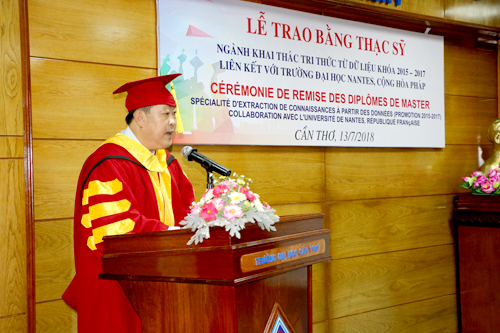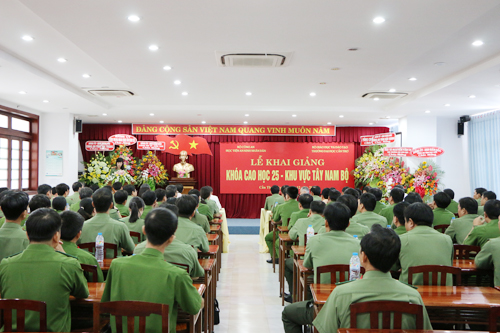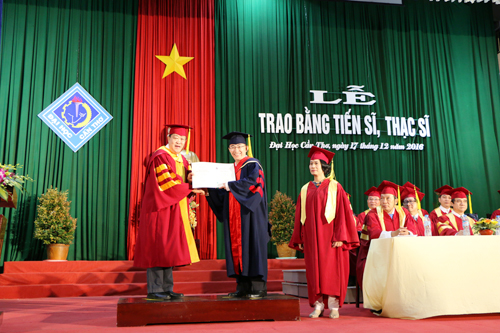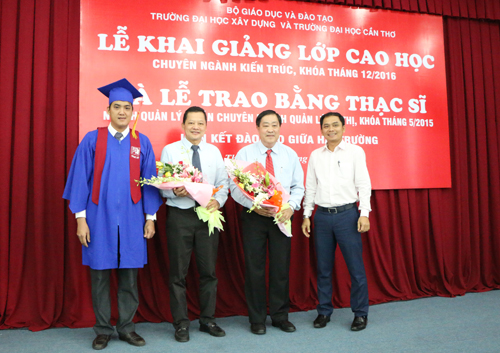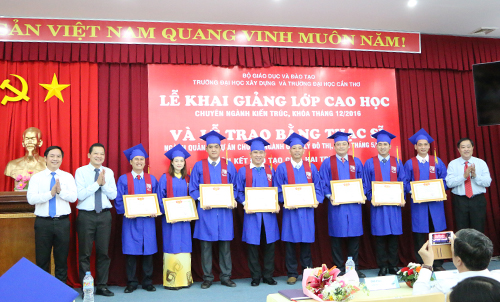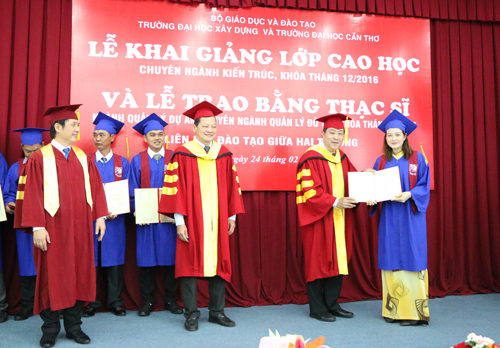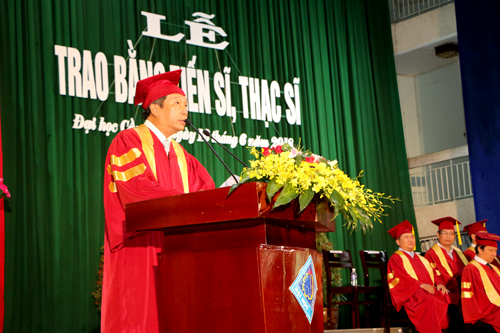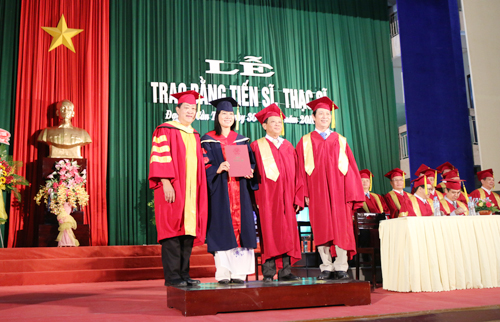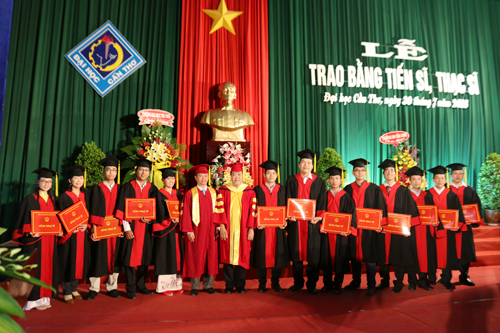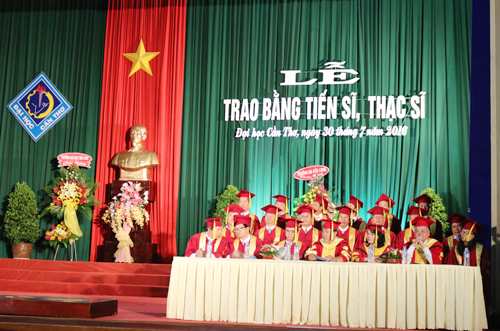
Tên đề tài: “Ảnh hưởng của một số thành phần dinh dưỡng đến hiệu quả sản xuất giống ốc bươu đồng (Pila polita Deshayes, 1830)”.
Tác giả: Lê Văn Bình, Khóa: 2022
Ngành: Nuôi trồng thủy sản; Mã số: 9620110. Nhóm ngành: Nông-Lâm-Ngư nghiệp
Người hướng dẫn: PGS.TS. Ngô Thị Thu Thảo - Trường Đại học Cần Thơ
- Tóm tắt nội dung luận án
Nghiên cứu ảnh hưởng của một số thành phần dinh dưỡng đến hiệu quả sản xuất giống ốc bươu đồng (Pila polita Deshayes, 1830) được tiến hành ở tỉnh Đồng Tháp và tại Trường Thủy sản, Đại học Cần Thơ. Thời gian thực hiện từ năm 2022 - 2024, nhằm xác định phương pháp thích hợp trong kích thích sinh sản nhân tạo và xác định nhu cầu hàm lượng protein, canxi, khoáng trong giai đoạn ương giống và nuôi vỗ, góp phần phát triển nghề sản xuất giống và nuôi ốc bươu đồng trong vùng.
Nhu cầu protein, canxi và khoáng của ốc bươu đồng giai đoạn nuôi vỗ làn lượt là 26,00% protein (SGRW: 0,78 %/ngày); 5,20% canxi (SGRW: 0,75 %/ngày) và 5,03% khoáng (SGRW: 0,78 %/ngày). Nuôi vỗ ốc bươu đồng ở hàm lượng protein 15% đạt tỉ lệ sống cao nhất (65,6%); khi sử dụng thức ăn có hàm lượng canxi 3% hay bổ sung 10 mg/L canxi vào môi trường nước có tỉ lệ sống cao nhất; bổ sung khoáng vào thức ăn để nuôi vỗ ốc bươu đồng đạt tỉ lệ sống cao hơn so với bổ sung vào môi trường nước. Hiệu quả sử dụng protein, canxi giảm dần theo sự gia tăng của hàm lượng protein, canxi trong thức ăn. Lượng thức ăn ốc bươu đồng tiêu thụ ở giai đoạn nuôi vỗ chịu ảnh hưởng đáng kể của các hàm lượng protein, canxi, khoáng khác nhau. Hàm lượng canxi và khoáng trong khẩu phần ăn từ 7 - 9% và trong môi trường nước từ 15 - 20 mg/L canxi và từ 70 đến 90 mg/m3 khoáng làm cho ốc bươu đồng có khuynh hướng tích lũy canxi ở vỏ nhiều hơn so với hàm lượng canxi hay khoáng thấp. Hàm lượng protein trong thịt ốc ở giai đoạn nuôi vỗ từ 52,8 đến 69,9% và có xu hướng tăng theo hàm lượng protein, canxi và khoáng trong thức ăn. Bổ sung hàm lượng canxi trong thức ăn, hàm lượng canxi trong thịt ốc bươu đồng cao hơn so với bổ sung protein trong thức ăn hay bổ sung khoáng trong thức ăn. Thức ăn với hàm lượng protein 25%, hàm lượng 5% canxi (khoáng) trong thức ăn và 10 mg/L canxi hay 30 mg/m3 khoáng trong môi trường nước sử dụng nuôi vỗ ốc bươu đồng đạt chỉ số tuyến sinh dục và hiệu quả sinh sản cao hơn so với thức ăn hay môi trường nước chứa hàm lượng protein, canxi, khoáng khác.
Nghiên cứu kích thích sinh sản ốc bươu đồng cho thấy, ốc bươu đồng khi kích thích sinh sản bằng các phương pháp (giảm chiều cao cột nước kết hợp với phơi trong bóng râm, chiếu tia cực tím hay giữ lạnh), ở nghiệm thức đối chứng có tỉ lệ sống cao hơn và khác biệt có ý nghĩa so với các phương pháp khác trong cùng thí nghiệm. Thời gian giữ khô 3 giờ; thời gian chiếu tia cực tím từ 15 phút đến 30 phút hay thời gian giữ lạnh 30 phút dẫn đến tỉ lệ ốc bươu đồng tham gia sinh sản, tần suất sinh sản và sức sinh sản cao so với các phương pháp kích thích sinh sản khác. Kích thích sinh sản bằng các phương pháp chiếu tia cực tím tỉ lệ ốc bươu đồng tham gia sinh sản, tần suất sinh sản và sức sinh sản cao hơn so với giảm chiều cao cột nước kết hợp với thời gian giữ khô hay phương pháp giữ lạnh. Chất lượng trứng ốc bươu đồng ảnh hưởng bởi các phương pháp kích thích sinh sản khác nhau; trong khi đó, ốc bươu đồng con mới nở không ảnh hưởng bởi phương pháp giảm chiều cao cột nước kết hợp với phơi trong bóng râm hay giữ lạnh.
Tốc độ tăng trưởng của ốc bươu đồng giai đoạn giống giảm khi hàm lượng bổ sung protein, canixi, khoáng quá cao hay bổ sung protein, canxi, khoáng thấp. Nhu cầu protein (28,36%; SGRW: 6,72 %/ngày), canxi (6,64%; SGRW: 7,70 %/ngày) và khoáng (6,98%; SGRW: 4,02 %/ngày) của ốc bươu đồng giống cho tăng trưởng tốt nhất. Ương giống với thức ăn có hàm lượng protein 20%, sử dụng thức ăn có hàm lượng canxi 3% hay bổ sung canxi 5 mg/L vào môi trường nước và sử dụng thức ăn có hàm lượng khoáng 7% hay bổ sung khoáng 90 mg/m3 vào môi trường nước đạt được tỉ lệ sống cao nhất; bổ sung khoáng vào thức ăn để ương hay nuôi vỗ ốc bươu đồng đã làm cho tỉ lệ sống đạt cao hơn bổ sung khoáng vào môi trường nước. Hiệu quả sử dụng protein, canxi giảm dần theo sự gia tăng của hàm lượng protein, canxi trong thức ăn. Lượng thức ăn chịu ảnh hưởng đáng kể của các hàm lượng protein, canxi, khoáng khác nhau. Hàm lượng canxi và khoáng trong khẩu phần ăn từ 7 đến 11% và trong môi trường nước từ 15 đến 20 mg/L canxi và từ 70 đến 90 mg/m3 khoáng làm cho ốc bươu đồng có khuynh hướng tích lũy canxi ở vỏ nhiều hơn so với hàm lượng canxi hay khoáng thấp.
- Những kết quả mới của luận án
Kết quả của nghiên cứu này đã có những đóng góp mới (về khoa học và thực tiễn) trong sản xuất giống ốc bươu đồng (Pila polita):
Luận án xác định được một số nội dung quan trọng trong sản xuất giống ốc bươu đồng. Đó là, đã xác định phương pháp kích thích sinh sản với thời gian giữ khô 3 giờ; thời gian chiếu tia cực tím từ 15 phút đến 30 phút hay thời gian giữ lạnh 30 phút sẽ cho kết quả tỉ lệ ốc bươu đồng tham gia sinh sản, tần suất sinh sản và sức sinh sản cao.
Nghiên cứu đã xác định hàm lượng protein, canxi, khoáng thích hợp cho giai đoạn ốc bươu đồng bố mẹ (lần lượt: 26,00%; 5,20% và 5,03%), giống (lần lượt: 28,36%; 6,64% và 6,98%) và góp phần nâng cao hiệu quả sinh sản đối với ốc bươu đồng cái; hiệu quả sử dụng protein, canxi giảm dần theo sự gia tăng của hàm lượng protein, canxi ở giai đoạn ốc bươu đồng giống và ốc bươu đồng bố mẹ, ốc bươu đồng giai đoạn bố mẹ có hiệu quả sử dụng protein, canxi luôn thấp hơn (cụ thể: protein thấp hơn 1,7 lần và canxi thấp hơn 1,8 lần) so với ốc bươu đồng giai đoạn giống; lượng thức ăn ốc bươu đồng tiêu thụ ở giai đoạn giống và giai đoạn nuôi vỗ đã chịu ảnh hưởng đáng kể của các hàm lượng protein, canxi và khoáng khác nhau; ở giai đoạn ốc bươu đồng nuôi vỗ có lượng thức ăn tiêu thụ luôn cao hơn so với ở giai đoạn ương giống.
Việc bổ sung canxi vào thức ăn, hàm lượng canxi trong thịt ốc bươu đồng ở giai đoạn nuôi vỗ cao hơn so với bổ sung protein trong thức ăn (cao hơn 1,78 lần) hay bổ sung khoáng trong thức ăn (cao hơn 1,83 lần). Khi bổ sung canxi trong thức ăn có hàm lượng canxi trong thịt ốc bươu đồng ở giai đoạn nuôi vỗ cao hơn so với bổ sung canxi môi trường nước; trong khi đó, bổ sung hàm lượng khoáng trong thức ăn hay môi trường nước có hàm lượng canxi trong thịt ốc bươu đồng ở giai đoạn nuôi vỗ tương đương nhau.
Các thí nghiệm bổ sung khoáng trong nuôi vỗ ốc bươu đồng (trong thức ăn hay môi trường nước) thu được trung bình thời gian ốc bươu đồng tham gia sinh sản ngắn hơn (giảm 0,75 đến 3,00 ngày), tỉ lệ nở cao hơn (tăng 2,70 đến 5,43%), thời gian nở rút ngắn hơn (giảm 0,27 đến 0,57 ngày) so với các thí nghiệm ảnh hưởng hàm lượng canxi khác nhau (trong thức ăn hay môi trường nước).
Từ kết quả nghiên cứu và tổng hợp các tài liệu liên quan, quy trình sản xuất ốc bươu đồng tại các tỉnh Đồng bằng sông Cửu Long được xây dựng và được tóm tắt như sau: (1) Nuôi vỗ thành thục ốc bươu đồng bố mẹ; (2) Kích thích sinh sản; (3) Kỹ thuật ấp trứng ốc bươu đồng; (4) Kỹ thuật ương ốc bươu đồng giống.
- Các ứng dụng/khả năng ứng dụng trong thực tiễn, các vấn đề cần tiếp tục nghiên cứu
3.1. Các ứng dụng/khả năng ứng dụng trong thực tiễn
- Đào tạo: Kết quả nghiên cứu là nguồn tư liệu tham khảo cho giảng viên và sinh viên ngành thủy sản.
- Nghiên cứu khoa học: Nghiên cứu cung cấp nhiều dẫn liệu mới về ứng dụng phương pháp kích thích sinh sản và hiệu quả sử dụng thức ăn (xác định nhu cầu protein, canxi và khoáng) trong ương và nuôi vỗ ốc bươu đồng, những dẫn liệu này có ý nghĩa khoa học và các nghiên cứu tiếp theo.
- Kinh tế: Kết quả của luận án đã góp phần cung cấp cơ sở cho việc áp dụng các giải pháp kỹ thuật trong sản xuất giống các loài thuộc lớp Chân bụng nước ngọt ở Việt Nam, cũng như trên thế giới. Sự thành công này có thể ứng dụng trong sản xuất giống, ương, nuôi ốc bươu đồng để thúc đẩy nghề nuôi phát triển và đa dạng hóa đối tượng nuôi nhằm duy trì và phát triển nguồn lợi, tạo ra sinh kế cho người dân, tạo ra sản phẩm đóng góp cho kinh tế xã hội. Ứng dụng kết quả nghiên cứu phương pháp kích thích sinh sản với thời gian giữ khô 3 giờ; thời gian chiếu tia cực tím từ 15 phút đến 30 phút hay thời gian giữ lạnh 30 phút. Ứng dụng trong ương giống: protein (28,36%), canxi (6,64%) và khoáng (6,98%); ứng dụng trong nuôi vỗ: protein (26,00%); canxi (5,20%) và khoáng (5,03%) của luận án dễ dàng vào thực tế sản xuất.
3.2 Các vấn đề cần tiếp tục nghiên cứu
Nghiên cứu nhu cầu photpho, tỉ lệ canxi/photpho, tỉ lệ đạm/carbohydrat để xác định nhu cầu dinh dưỡng cho ốc bươu đồng giai đoạn giống và nuôi vỗ.
Thesis title: The effects of some nutritional compositions on the production efficiency of black apple snail (Pila polita Deshayes, 1830).
- Major: Aquaculture. Code: 9620301.
- Full name of PhD student: Le Van Binh. Year: 2022, round 2.
- Scientific supervisor: Assoc. Prof. Dr. Ngo Thi Thu Thao.
- Educational institution: Can Tho University.
- Content of thesis summary
The study on the effects of some nutritional ingredients on the production efficiency of black apple snail (Pila polita Deshayes, 1830) was carried out in Dong Thap province and at the College of Aquaculture and Fisheries, Can Tho University from 2022 to 2024. The objectives of this study were to determine appropriate methods to stimulate artificial reproduction, to determine the dietary protein, calcium, and minerals during the juvenile nursing and broodstock conditioning stages, thereby contributing to the development of seed production and farming of black apple snails in the region.
The ideal protein, calcium, and mineral requirements of black apple snails (Pila polita) during the conditioning stage were 26.00% protein (SGRW: 0.78 %/day), 5.20% calcium (SGRW: 0.75 %/day), and 5.03% minerals (SGRW: 0.78 %/day). Conditioning snails with a diet containing 15% protein resulted in the highest survival rate (65.6%). When using feed with 3% calcium or supplementing the water with 10 mg/L of calcium, the highest survival rate was also observed. Adding minerals directly to the feed led to a higher survival rate than adding them to the water environment. The efficiency of protein and calcium utilization decreased as the levels of protein and calcium in the feed increase. The amount of feed consumed by black apple snails during the conditioning stage was significantly affected by varying levels of protein, calcium, and minerals. Calcium and mineral contents in the diet ranging from 7% to 9%, and in the water environment from 15 to 20 mg/L of calcium and from 70 to 90 mg/m³ of minerals, tend to promote greater calcium accumulation in the shell compared to lower levels of calcium or minerals. The protein content in the flesh of black apple snails during the conditioning stage ranged from 52.8% to 69.9% and tended to increase with higher levels of protein, calcium, and minerals in the feed. Supplementing calcium in the feed resulted in a higher calcium content in the snail’s flesh compared to supplementing protein or minerals in the feed. Feed containing 25% protein and 5% calcium (minerals), along with 10 mg/L of calcium or 30 mg/m³ of minerals in the water environment, resulted in a higher gonad index and reproductive efficiency in apple snails during the conditioning stage compared to feeds or water environments with different levels of protein, calcium, and minerals.
In the experiment to induce spawning of black apple snails, the survival rate of black apple snails was higher in the control treatment (no dry, no UV, or no cold) compared to other methods such as reduction in water column height in combination with sun exposure, UV irradiation, or cold retention. Dry holding time of 3 hours, UV irradiation time from 15 minutes to 30 minutes, or cold holding time of 30 minutes all result in a high spawning rate, reproductive efficiency, and fertility when compared to other water exchange regimes. UV irradiation approaches were more effective at increasing spawning rate, reproductive efficiency, and fertility than decreasing water column height in conjunction with sun exposure or cold retention. The quality of snail eggs was influenced by various water exchange regimes. However, the weight and height of newly hatched snails were unaffected by the strategy of reducing water column height in conjunction with sun exposure or cold retention.
The growth rate of juvenile black apple snails decreases when the levels of supplemented protein, calcium, or minerals are either too high or too low. A diet containing protein (28.36%), calcium (6.64%), and minerals (6.98%) resulted in the best growth performance for juvenile black apple snails, with corresponding daily weight gain rates of 6.72%, 7.70%, and 4.02%, respectively. Nursery rearing with feed containing 20% protein, using feed with 3% calcium or supplementing 5 mg/L of calcium into the water, and using feed with 7% minerals or supplementing 90 mg/m³ of minerals into the water resulted in the highest survival rate. Adding minerals directly to the feed for nursery of apple snails led to a higher survival rate compared to adding minerals to the water environment. Nursery rearing with feed containing 20% protein, using feed with 3% calcium or supplementing 5 mg/L of calcium into the water, and using feed with 7% minerals or supplementing 90 mg/m³ of minerals into the water resulted in the highest survival rate. Adding minerals directly to the feed for nursery or conditioning of apple snails led to a higher survival rate compared to adding minerals to the water environment. The efficiency of protein and calcium utilization decreased as their levels in the feed increase. Feed intake was significantly affected by the varying levels of protein, calcium, and minerals. Calcium and mineral contents in the diet ranging from 7% to 11%, and in the water environment from 15 to 20 mg/L of calcium and 70 to 90 mg/m³ of minerals, lead to a greater tendency for apple snails to accumulate calcium in their shells compared to lower levels of calcium or minerals.
- The novel aspects from the thesis
The results of this study have made new contributions (both scientific and practical) to the seed production of the field black apple snail (Pila polita):
The dissertation identified several important aspects in the seed production of Pila polita. Specifically, it determined that reproductive stimulation methods such as maintaining dryness for 3 hours, ultraviolet irradiation for 15 - 30 minutes, or cold storage for 30 minutes yielded high rates of reproductive participation, spawning frequency, and reproductive capacity in field snails.
The study determined the appropriate levels of protein, calcium, and minerals for the seed stage (28.36%, 6.64%, and 6.98%, respectively) and for broodstock (26.00%, 5.20%, and 5.03%, respectively), thereby contributing to improved reproductive performance of female snails. The efficiency of protein and calcium utilization decreased as their dietary levels increased in both the seed and broodstock stages. Broodstock snails always showed lower utilization efficiency (protein 2.9 times lower and calcium 2.5 times lower) than seed-stage snails. Feed intake at both seed and broodstock stages was significantly affected by varying protein, calcium, and mineral levels, with broodstock snails consistently consuming more feed than seed-stage snails.
Supplementing calcium in feed increased calcium content in broodstock snail flesh more than protein supplementation (1.78 times higher) or mineral supplementation (1.83 times higher). Moreover, calcium supplementation in feed yielded higher calcium content in broodstock snail flesh than calcium supplementation through water. Meanwhile, mineral supplementation, whether through feed or water, produced equivalent calcium content in broodstock snail flesh.
Experiments on mineral supplementation (via feed or water) during broodstock rearing resulted in shorter average spawning latency (reduced by 0.75–3.00 days), higher hatching rates (increased by 2.70 - 5.43%), and shorter incubation periods (reduced by 0.27 - 0.57 days) compared to experiments testing different calcium levels (via feed or water).
From the research results and the review of related documents, the production process of the black apple snails (Pila polita) in the Mekong Delta provinces has been developed and summarized as follows: (1) Conditioning and maturation of broodstock black apple snails; (2) Reproduction stimulation; (3) Incubation techniques for black apple snail eggs; (4) Nursery techniques for juvenile black apple snails.
- Application prospect and suggestions for further study
3.1. Practical applications and potential uses
- Training: The research results serve as a valuable reference for lecturers and students in the field of aquaculture.
- Scientific research: The study provides new data on the application of reproductive stimulation methods and the efficiency of feed utilization (defining protein, calcium, and mineral requirements) in seed rearing and broodstock rearing of Pila polita. These findings carry scientific significance and create a foundation for further studies.
- Economics: The dissertation contributes to establishing a technical basis for applying solutions in the seed production of freshwater gastropods in Vietnam and worldwide. This success can be applied in hatchery, nursery, and farming of Pila polita to promote industry development, diversify cultured species, sustain and enhance natural resources, generate livelihoods, and create products contributing to socio-economic growth. The application of reproductive stimulation methods (dry storage for 3 hours, UV irradiation for 15–30 minutes, or cold storage for 30 minutes) as well as the use of feed formulations in nursery (protein 28.36%, calcium 6.64%, minerals 6.98%) and broodstock rearing (protein 26.00%, calcium 5.20%, minerals 5.03%) can be readily transferred into practical production.
3.2. Issues for further research
Future studies should investigate the requirements for phosphorus, the calcium/phosphorus ratio, and the protein/carbohydrate ratio to determine the precise nutritional needs of Pila polita during the seed and broodstock stages.
- Xem chi tiết nội dung luận án
- Xem thông tin đăng tải tại Website Bộ giáo dục và Đào tạo. (Nhập tên NCS vào ô tìm kiếm)





